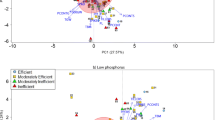Abstract
Soil acidity in the Great Plains of the USA can reduce forage and grain yields of winter wheat, primarily by Al toxicity. Indigenous cultivars may vary in seedling tolerance to Al toxicity, but the benefit that Al tolerance provides to forage and grain production is not well documented in this region. Backcrossed-derived lines of ‘Chisholm’ and ‘Century’ were selected with an additional gene from ‘Atlas 66’ conferring Al tolerance in solution culture. Our objective was to determine the impact of this source of Al tolerance on forage production prior to the jointing stage and subsequent grain yield. Experiments were conducted at several locations on non-limed (pH=4.5–4.7) and limed soils (pH=5.2-6.1) in Oklahoma. Two cultivars (‘TAM 105’, susceptible; ‘2180’, tolerant) with extreme differences in Al tolerance were used as controls . In limed conditions, forage and grain production did not differ between Al-tolerant and -susceptible genotypes, indicating a neutral effect of the Atlas 66 gene in the absence of Al toxicity. Despite visual differences in early-season plant vigor in non-limed acid soil, the Al-tolerant selections did not yield greater season-long forage than their susceptible parents. At sites where Al saturation in the non-limed soil exceeded 30%, spike production at maturity was nearly doubled in the Century background by the addition of Al tolerance, but final grain yield was not significantly improved. In the Chisholm background, grain yield was improved 50 to 74% by Al tolerance. The magnitude of the agronomic benefit of Al tolerance was highly influenced by the edaphic environment and genetic background. Acid soils of the Great Plains appear highly variable in Al toxicity; hence, consideration of the target environment is essential to predict the potential impact of Al tolerance selected in solution culture.
Similar content being viewed by others
References
Aniol A 1990 Genetics of tolerance to aluminium in wheat Triticum aestivumL. Thell). Plant Soil 123, 223-27.
Berzonsky W A 1992 The genomic inheritance of aluminum tolerance in 'Atlas 66' wheat. Genome 35, 689-693.
Bona L, Baligar V C and Wright R J 1995 Soil acidity effects on agribotanical traits of durum and common wheat. InPlant and Soil Interactions at Low pH. Ed. R A Date et al. pp 425-428. Kluwer Academic Publishers, Dordrecht, The Netherlands.
Carver B F, Inskeep W P, Wilson N P and Westerman R L 1988 Seedling tolerance to aluminum toxicity in hard red winter wheat germplasm. Crop Sci. 28, 463-467.
Carver B F, Whitmore W E, Smith E L and Bona L 1993 Registration of four aluminum-tolerant winter wheat germplasms and two susceptible near-isolines. Crop Sci. 33, 1113-1114.
Carver B F and Ownby J D 1995 Acid soil tolerance in wheat. Adv. Agron. 54, 117-173.
Cochran T T, Sanchez L G, Azevedo L G, Porros J A and Garver C L 1985 Land in tropical America. Vol. 1. CIAT, Cali Columbia and EMBRAPA-CPAC. Planaltina, D.F. Brazil.
Foy C D, Fleming A L and Schwartz J W 1973 Opposite aluminum and manganese tolerances of two wheat varieties. Agron. J. 65, 123-126.
Johnson J P Jr, Carver B F, Baligar V C and Raun W R 1996 Expression of aluminum tolerance transferred from Atlas 66 to hard winter wheat. Crop Sci. 36 (In press).
Krenzer G and Singleton L 1995 Root rots in wheat. Oklahoma Cooperative Ext. Serv. PT 95-15.
Murray G M, Scott B J, Hochman Z and Butler B J 1987 Failure of liming to increase grain yield of wheat and triticale in acid soils may be due to the associated increase in incidence of take-all (Gaeumannomyces graminisvar. tritici). Aust. J. Exp. Agric. 27, 411-417.
Olsen S R and Sommers L E 1982 Phosphorus. InMethods of Soil Analysis. Part 2. Ed. A L Page. pp 403-430. Agron 9, ASA, SSSA, Madison, WI, USA.
Riede C R and Anderson J A 1996 Linkage of RFLP markers to a wheat aluminum tolerance gene. Crop Sci. 36 (In press).
Thomas G W 1982 Exchangeable cations. InMethods of Soil Analysis. Part 2. Ed. A L Page. pp 159–165. Agron 9. ASA, SSSA, Madison, WI, USA.
Ud-Din N, Carver B F and Krenzer E G Jr 1993 Visual selection for forage yield in winter wheat. Crop Sci. 33, 41-45.
Winter S R and Thompson E K 1990 Grazing winter wheat: I. Response of semidwarf cultivars to grain and grazed production systems. Agron. J. 82, 33-37.
Author information
Authors and Affiliations
Rights and permissions
About this article
Cite this article
Johnson Jr, J., Carver, B. & Baligar, V. Productivity in Great Plains acid soils of wheat genotypes selected for aluminium tolerance. Plant and Soil 188, 101–106 (1997). https://doi.org/10.1023/A:1004268325067
Issue Date:
DOI: https://doi.org/10.1023/A:1004268325067




